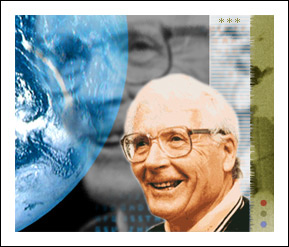 The Gaia hypothesis is an ecological hypothesis proposing that the biosphere and the physical components of the Earth (atmosphere, cryosphere, hydrosphere and lithosphere) are closely integrated to form a complex interacting system that maintains the climatic and biogeochemical conditions on Earth in a preferred homeostasis. Originally proposed by James Lovelock as the earth feedback hypothesis,[1] it was named the Gaia Hypothesis after the Greek supreme goddess of Earth.[2] The hypothesis is frequently described as viewing the Earth as a single organism. Lovelock and other supporters of the idea now call it Gaia theory, regarding it as a scientific theory and not mere hypothesis, since they believe it has passed predictive tests.[3]
The Gaia hypothesis is an ecological hypothesis proposing that the biosphere and the physical components of the Earth (atmosphere, cryosphere, hydrosphere and lithosphere) are closely integrated to form a complex interacting system that maintains the climatic and biogeochemical conditions on Earth in a preferred homeostasis. Originally proposed by James Lovelock as the earth feedback hypothesis,[1] it was named the Gaia Hypothesis after the Greek supreme goddess of Earth.[2] The hypothesis is frequently described as viewing the Earth as a single organism. Lovelock and other supporters of the idea now call it Gaia theory, regarding it as a scientific theory and not mere hypothesis, since they believe it has passed predictive tests.[3]
Contents |
History
The Gaia hypothesis was first scientifically formulated in the 1960s by the independent research scientist James Lovelock, as a consequence of his work for NASA on methods of detecting life on Mars.[4][5] He initially published the Gaia Hypothesis in journal articles in the early 1970s[6][7] followed by a popularizing 1979 book Gaia: A new look at life on Earth.
The theory was initially, according to Lovelock, a way to explain the fact that combinations of chemicals including oxygen and methane persist in stable concentrations in the atmosphere of the Earth. Lovelock suggested using such combinations detected in other planets' atmospheres would be a relatively reliable and cheap way to detect life, which many biologists opposed at the time and since. Later other relationships such as the fact that sea creatures produce sulfur and iodine in approximately the quantities required by land creatures emerged and helped bolster the theory. Rather than invent many different theories to describe each such equilibrium, Lovelock dealt with them holistically, naming this self-regulating living system after the Greek goddess Gaia, using a suggestion from the novelist William Golding, who was living in the same village as Lovelock at the time (Bowerchalke, Wiltshire, UK). The Gaia Hypothesis has since been supported by a number of scientific experiments[8] and provided a number of useful predictions,[9] and hence is properly referred to as the Gaia Theory.
Since 1971, the noted microbiologist Dr. Lynn Margulis has been Lovelock's most important collaborator in developing Gaian concepts.[10]
Until 1975 the hypothesis was almost totally ignored. An article in the New Scientist of February 15, 1975, and a popular book length version of the theory, published in 1979 as The Quest for Gaia, began to attract scientific and critical attention to the hypothesis. The theory was then attacked by many mainstream biologists. Championed by certain environmentalists and climate scientists, it was vociferously rejected by many others, both within scientific circles and outside them.
Lovelock's initial hypothesis
James Lovelock defined Gaia as:
- a complex entity involving the Earth's biosphere, atmosphere, oceans, and soil; the totality constituting a feedback or cybernetic system which seeks an optimal physical and chemical environment for life on this planet.



 Gaia
Gaia




